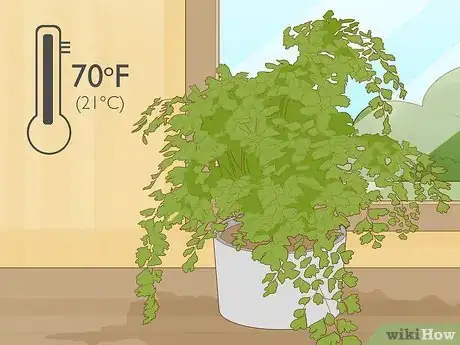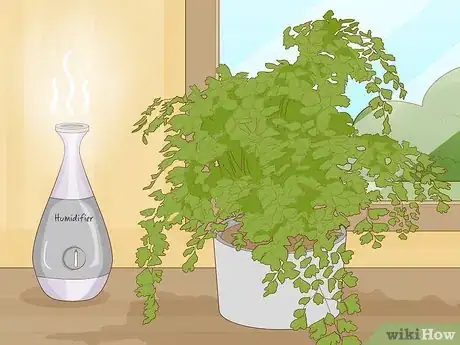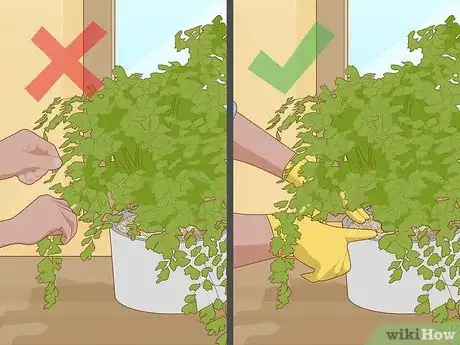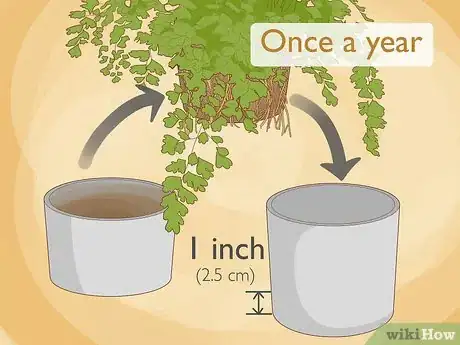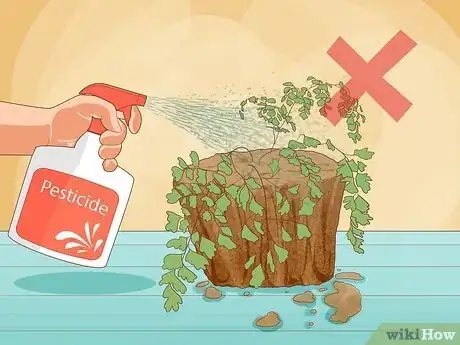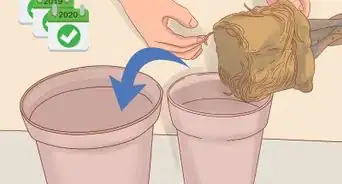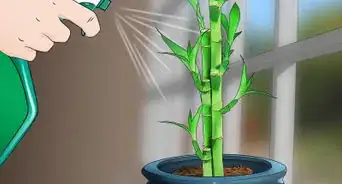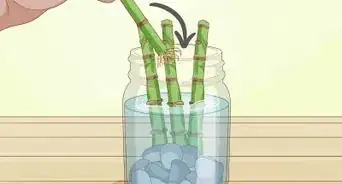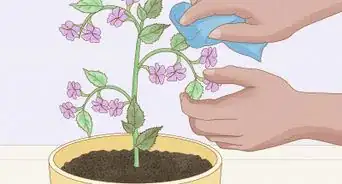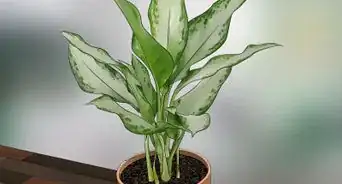This article was co-authored by Mark Leahy. Mark Leahy is a Plant Specialist based in the San Francisco Bay Area. He is the Co-Owner of Bella Fiora, a custom design floral studio, and SF Plants, a plant shop and nursery. Mark specializes in floral artistry and indoor plants including floral arrangements, terrace planters, office plantscapes, and living walls. Mark and his business partner have been featured in Vogue, The Knot, Today’s Bride, Wedding Wire, Modern Luxury, San Francisco Bride Magazine, San Francisco Fall Antique Show, Black Bride, Best of the Bay Area A-List, and Borrowed & Blue.
wikiHow marks an article as reader-approved once it receives enough positive feedback. In this case, several readers have written to tell us that this article was helpful to them, earning it our reader-approved status.
This article has been viewed 95,800 times.
Maidenhair ferns have delicate lacy leaves on wiry stems. But these beautiful plants have a reputation for being high maintenance. Keeping a maidenhair fern happy doesn't have to be intimidating. They thrive in warm, moist air and need frequent watering. Keep them away from drafts, avoid touching them too much, and trim away any dying fronds and your maidenhair fern can thrive.
Steps
Maintaining an Ideal Environment
-
1Place your fern where it will get 4-6 hours of indirect sunlight a day. A north-facing windowsill is usually a good place to keep a maidenhair fern, as the fern won't receive much direct light. An east-facing window also works, since morning light is more gentle. If you keep the fern at a south- or west-facing window, keep it 1 foot (30 cm) away from the sill, since the direct sunlight can singe its delicate leaves.[1]
- Light is the most important factor in keeping your fern alive and happy.
- You can also grow maidenhair ferns under fluorescent grow lights in terrariums.
- If your maidenhair gets direct sunlight, be extra-vigilant about watering it, as it will dry out more quickly.
-
2Keep the soil evenly moist in the pot. Water your fern enough so that the surface never dries out. However, don't water your fern so much that the soil becomes soggy. Water the plant evenly on all sides as often as daily. To check if your maidenhair fern needs water, lift the pot. If it is half as heavy as when it is freshly watered, it's time.
- Remember that air conditioning or heat can both dry out the soil. If you have the air or heat on, you'll need to water your fern more often.
- Check if your maidenhair fern needs to be watered every day.
Advertisement -
3Control the temperature to keep it around 70 °F (21 °C). Maidenhair ferns typically can't sustain in temperatures lower than 60 °F (16 °C). However, they prefer temperatures around 70 °F (21 °C) and higher.[2]
- Don't worry too much if the temperature drops temporarily, but make sure to warm your fern up as soon as you can.
-
4Maintain high humidity around the fern with a humidifier. Use a humidifier to create ideal conditions for your fern, especially in the winter. Or, try misting the fern daily with warm water in a spray bottle to create humidity.[3]
- If you aren't able to run a humidifier, be sure to check the soil vigilantly, as it may dry out quickly without it.
- Alternatively, try keeping the fern in a bathroom where the steam from the shower will keep it moist.
- You can also use a terrarium or glass case to maintain humidity levels around the fern, but remember not to place it in direct sunlight.
-
5Position your maidenhair fern away from drafts. Any moving air can evaporate moisture and dry out your fern. Keep your maidenhair fern away from any exterior doors, drafty windows, fans, air conditioners, and radiators.
- It can be tricky to find the right balance of indirect light while avoiding drafts. Try placing your fern in a room with large east- or west-facing windows on a flat surface away from the window.
-
6Fertilize the fern twice monthly in the fall through spring. Use an organic liquid fertilizer, mixed with an equal amount of water. Add fertilizer to the soil every 2 weeks from around September through March.[4]
- Maidenhair ferns like fertilizers that contain fish emulsions.
Dealing with Common Issues
-
1Avoid touching the leaves and wear gloves during routine maintenance. The oil from your fingers can block the leaves from absorbing moisture. Although it can be tempting to touch the soft leaves, avoid it as much as possible.
- If you must handle the leaves to prune or repot your fern, wear plastic gloves.
-
2Trim dead fronds and leaf tips with scissors to stimulate healthy growth. If you notice any fronds or leaves start to turn brown, don't panic, this is normal. Trim off any of the plant that has died, down to the soil. This will allow the plant to grow new fronds.
- If the entire plant turns brown and dry, the plant is dying and needs to be revived.
-
3Repot your fern up to once a year when the roots get crowded. Repot your maidenhair in a new container only one size, or about 1 inch (2.5 cm) bigger than its current container. Maidenhair ferns don't like a lot of space for their roots. They prefer to fit very snugly into their container.
- Maiden hairs don't like to be repotted too often, so avoid it as much as possible.
-
4Propagate your fern while repotting it to grow new ferns. In order to propagate your maidenhair, pull it out of the soil while being careful to leave the roots intact. Use a sharp pair of scissors to cut the root ball into 2 separate segments with at least 3 fronds each. Replant each segment in its own pot and care for both as you would a fully-grown maidenhair fern.
- If you are having success with your first maidenhair fern, this can be a sign that you're ready to propagate the plant.
-
5Avoid pesticides and treat common pests with natural solutions. Aphelenchoides cause brown leaves. To get rid of them, simply cut off any brown leaves and dispose of them. Aphids are small, white insects that eat the leaves. Spray them with a hard stream of water to remove them, or a solution of soap and water if they are still alive the next day. Spider mites live underneath the leaves and cause wilting. Cover your fern with a translucent plastic bag to kill them. Continue to water your fern normally during this time.[5]
- Maidenhair ferns tend to respond poorly to pesticides because they are so delicate.
-
6Remove the fern from waterlogged soil to prevent root rot. Root rot is a disease that can infect any plant sitting in waterlogged soil. If you can see soft, white roots through wet soil, remove the maidenhair fern and brush all of the soil off of the roots. Cut off any softened, white roots with a sharp knife or scissors. Let the roots dry out and harden for a couple of days. Once they are solid and rigid, you can repot the plant in fresh soil.[6]
- Avoid overwatering your maidenhair fern to prevent root rot.
-
7Trim all of the fronds and soak the soil of a dying fern to revive it. If the whole plant turns brown and feels dry, don't panic. Simply trim down all of the fronds to soil level. Then place the entire container into water. Drain out any excess water. After a few days, new fronds will start to shoot up.
- Keep the soil moist while you are reviving a dying maidenhair fern.
- A maidenhair fern isn't considered dead until 18 months with no new growth.
Community Q&A
-
QuestionMy fern has black spots around the edge of each leaf. What do I need to do?
 Community AnswerDo not panic. These are the spores of the fern--the female portion. The spores are miniscule seeds of the fern. As long as you see these, you are doing great!
Community AnswerDo not panic. These are the spores of the fern--the female portion. The spores are miniscule seeds of the fern. As long as you see these, you are doing great! -
QuestionWhat do I do if my maidenhair fern isn't producing fronds?
 Community AnswerIt may not be getting enough fertilizer or light. Try fish emulsion fertilizer and a brighter location! Refresh it by placing the plant outdoors. All ferns LOVE fresh air.
Community AnswerIt may not be getting enough fertilizer or light. Try fish emulsion fertilizer and a brighter location! Refresh it by placing the plant outdoors. All ferns LOVE fresh air. -
QuestionWhat can I do if I am keeping a plant moist as directed, but entire fronds are drying out on it?
 Community AnswerThis fern must have either a humidifier, a pot set on rocks that remain moist, or it must be lightly sprayed with room temperature water.
Community AnswerThis fern must have either a humidifier, a pot set on rocks that remain moist, or it must be lightly sprayed with room temperature water.
Things You’ll Need
- Houseplant fertilizer
- Misting bottle
- Scissors
References
- ↑ https://www.apartmenttherapy.com/maidenhair-fern-a-difficult-diva-plant-hard-to-keep-alive-241042
- ↑ https://parade.com/845744/juliebawdendavis/grow-maidenhair-fern-in-your-indoor-garden/
- ↑ https://www.apartmenttherapy.com/maidenhair-fern-a-difficult-diva-plant-hard-to-keep-alive-241042
- ↑ https://parade.com/845744/juliebawdendavis/grow-maidenhair-fern-in-your-indoor-garden/
- ↑ https://www.plantopedia.com/adiantum/#pests
- ↑ https://www.plantopedia.com/adiantum/#diseases


